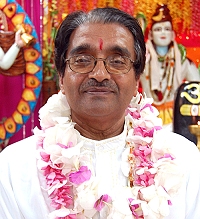Paramacharya of SWAHA, H.H. Pt. Hardeo Persad
Yajurveda states, “Yatha pinde tatha brahmande, yatha brahmande tatha pinde,” that is, “As the microcosm, so is the macrocosm; as the macrocosm, so too, the microcosm.” Contextually applied, the sacred rivers that flow through India also flow metaphysically within the subtle body of man. The Ida Naadi, Pingla Naadi and Sushumna Naadi are three major naadis or channels of bioenergy that are a source of sustenance to humans. They are symbolic of the three main rivers and signify devotion, knowledge and disinterested action. As the three rivers merge in Triveni at Prayag, India, so too within the individual, these naadis merge at Ajnaa Chakra, the subtle energy vortex in the forehead. Here, the harmonized, rhythmic flow of devotion, accelerated by wisdom and disinterested action, merges into a unifying flow of blessedness.
The blessedness resulting from the flow of devotion is also stated in Shri Raamcharitramaanas, where Shri Tulsidasji says that that land is blessed wherever Ganga flows. Intensely pursuing the path of devotion, in accordance with scriptural injunctions, is akin to diving into the purifying depths of the Ganga, and is most conducive to the attainment of the state of oneness with the Divine.
The Impurities in Ganga
According to studies done on River Ganga, these sacred waters suffer from extreme pollution levels. The river has undergone environmental ravages and other anthropogenic stress. Increasing population has led to industrialization, urbanization and poverty and has impacted negatively on the river. Most of the river’s pollution is due to the disposal of impurities into its waters.
Today, spiritual pollution and degeneration are identified with Kali Yuga, the final age of the universal cycle. So too, the inner Ganga is becoming polluted over time by the devolution in religious practices, the objective of which is rapidly shifting from attaining oneness with the Divine to attaining material interests. At times, negative qualities contaminate our actions so much so that the inner Ganga becomes polluted, stemming the tide of its harmonious, unifying flow within. Such actions are mere exhibition and are termed outward devotion.
To purify this inner stream of devotion, one needs to sincerely perform the necessary practices through which one can reach the stage of ekaant bhakti, where the focus is on the Supreme Objective. One needs to purify the inner Ganga and divert the course of materialistic practices that have infiltrated our spiritual quest and rise to the level where the inner Ganga flows continuously, gracefully and with a spontaneous outpouring of abundance of purity.
Purification of Ganga
Just as regular cleansing of the Ganga River is done, so too, the process of purifying the inner Ganga should be an unceasing one. To cultivate this supreme love towards God, man is guided by the Shrimad Bhagavatam in the discourse of Prahlad to his father, Hiranyakashipu. Also, Lord Raama’s explanation to the devotee, Shabri in the Raamaayan is similarly espoused in the following practices that are suggested for all in this age:
- Satsang – Keeping the company of the holy ones
- Sravanam – Listening to the glories of the Lord
- Guru seva – Performing selfless service to the Guru
- Kirtanam – Singing the praises of the Lord’s virtues
- Mantra jaap – Chanting His name with steadfast faith
- Archanam – Practising self-control, good character, detachment and dharma
- Samadrishti – Practising equanimity of mind and perceiving the world as
God himself
- Santosh – Attaining a state of contentment and desirelessness
- Bharosa – Having full faith in the Divine.
In addition to these daily practices, the rites and rituals enshrined in Hinduism constantly offer opportunities to maintain the purity of the inner Ganga, to climb spiritual heights and to realize one’s true nature. Purificatory rites, essential in almost every ritual and religious observance of Hinduism, exemplify the need for sanctity.
This immersion in the waterways serves as a reminder of the constant need to immerse ourselves in spirituality instead of materialism, to make a conscientious effort to transform our lives, and become one with the pure Ganga. Such purification symbolises our inner victory over negative qualities and materialism. It infuses the purifying flow of spiritual abundance and enlightened vision with its attendant positive qualities of serenity, faith, endurance, tranquillity of mind, control of the senses and renunciation of selfish actions and desires. In a state of purified devotion, one realises the divinity within.
As we observe the auspicious occasion of Ganga Dashami, we should continue our inner journey towards self-realization. It is incumbent upon all to make consistent efforts to immerse daily in the essence of pure devotion. It is the easiest, surest and safest way to achieve such inner purification.



